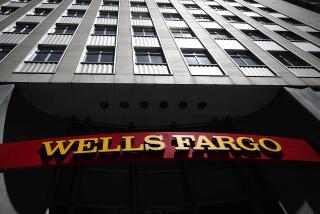‘They destroyed me.’ Wells Fargo’s mistake forced her to sell her home
- Share via
Michaela Christian lost a long battle with Wells Fargo in 2013 to save her Las Vegas home, a defeat she says changed the course of her life. When the bank refused to modify her mortgage, Christian moved in with a friend and scrambled to rebuild her life.
Five years later, Wells Fargo admits it made a mistake. Christian, 46, qualified for the kind of mortgage help that may have saved her home after all.
It is a mistake the giant bank admits it made nearly 900 times over several years, pushing hundreds of distressed homeowners into foreclosure.
Christian said that when she learned of Wells Fargo’s error, “I was sick to my stomach.”
“They destroyed me and destroyed my everything.”
Wells Fargo’s admission is part of a cascade of lapses that increased scrutiny of the San Francisco bank with some Democrats in Congress calling for the ouster of its chief executive, Tim Sloan. Over the last two years, the bank paid more than $1 billion in fines after admitting it opened millions of bogus accounts customers didn’t want and then found itself in more trouble after improperly repossessing thousands of cars.
The bank has repeatedly apologized for its missteps but is struggling to repair its image. Customers who lost their homes are being offered compensation or can enter mediation, company officials say.
Wells Fargo says an internal review found the bank denied help to hundreds of homeowners after fees charged by foreclosure attorneys were improperly used when the bank determined whom to offer mortgage help. The computer error began in 2010 and was not corrected until last April, the bank said.
Overall, 870 homeowners were denied help for which they qualified, including 545 who lost their homes to foreclosure. Wells Fargo says it has reached most of the customers affected and set aside $8 million to compensate them, though industry analysts say that number is likely to increase.
The revelation echoes the complaints of thousands of borrowers in the years after the financial crisis that banks were stingy about offering help with borrowers’ exploding loans.
“Wells Fargo failed to maintain its systems, failed to find problems when they occurred and then masked the problem for years,” said Alys Cohen, staff attorney for the National Consumer Law Center.
Christian bought her home in 1998, when she was just 24. At the time, the three-bedroom home was on the outskirts of a growing Las Vegas. There weren’t a lot of stores nearby, but Christian said she loved the neighborhood. “In the 15 years we were there, everything was perfect,” she said.
But in 2011, Christian lost her job as a bartender as the economy continued to sputter after the global financial crisis. Then she was in a car accident that left her with a fractured pelvis and crushed tibia. “I wasn’t even able to walk for seven months. I couldn’t work.”
One of her first calls for help, she said, was to Wells Fargo. Christian asked the bank to defer her more than $1,000 monthly mortgage payment or lower the 7% mortgage interest rate to the prevailing rate at the time, about 4%. That would have lowered her payments to about $500 a month, Christian said.
“They said, ‘Have a nice day’ and denied it,” she said.
A few months later, Christian said, Wells Fargo began foreclosure proceedings against her. With the help of her father, she found a job that allowed her to maneuver with a cane, and spent months searching for help, she said. Christian said she even offered Wells Fargo an additional $4,000 to make up for some of her missed payments.
Ultimately, Christian said, she faced what she considered an unfathomable choice: sell her home or lose it in foreclosure.
“It was the last thing I wanted,” she said. “I didn’t want to uproot my son. He had grown up there.”
After a quick sale of the home, Christian temporarily moved in with a friend and then into an apartment.
“I was in a daze,” Christian said through tears. “I thought, 100%, I was going to be able to save my home. I had my finances in order. I could not for the life of me figure out why they wouldn’t refinance.”
The answer came in September when Christian received a letter and a $15,000 check from Wells Fargo, admitting its mistake.
“We want to make things right,” the letter states. “We realize that our decision impacted you at a time you were facing a hardship.”
Wells Fargo’s letter didn’t explain how it determined Christian was due only $15,000. She sold the home for $135,000 in 2013; Redfin now estimates it is worth about $250,000. And Christian estimates she had already accumulated about $30,000 in equity after making mortgage payments for more than a decade. And that, she said, doesn’t include the $20,000 pool she had installed.
“You can’t put a price on what we lost. The scars will be there forever. I will never get over it,” said Christian, now part of a class-action lawsuit against the bank. “I still miss my neighbors.”
Wells Fargo has declined to discuss what, if any, formula it has used to determine how much each customer is owed. The compensation offered each homeowner is based on “individual circumstances,” said Tom Goyda, a bank spokesman.
Wells Fargo worked extensively with Christian and “completed multiple reviews in an effort to find an option that would allow her to keep the home,” Goyda said. Unfortunately, he said, the bank was unsuccessful.
More to Read
Inside the business of entertainment
The Wide Shot brings you news, analysis and insights on everything from streaming wars to production — and what it all means for the future.
You may occasionally receive promotional content from the Los Angeles Times.










